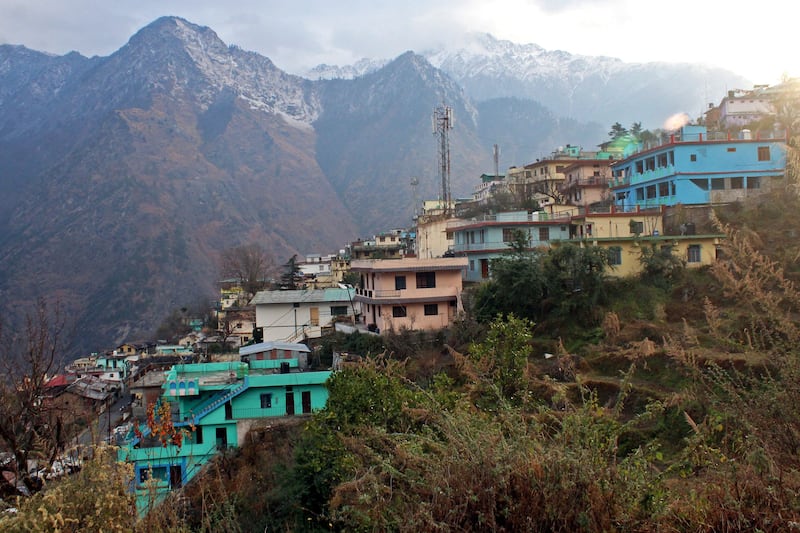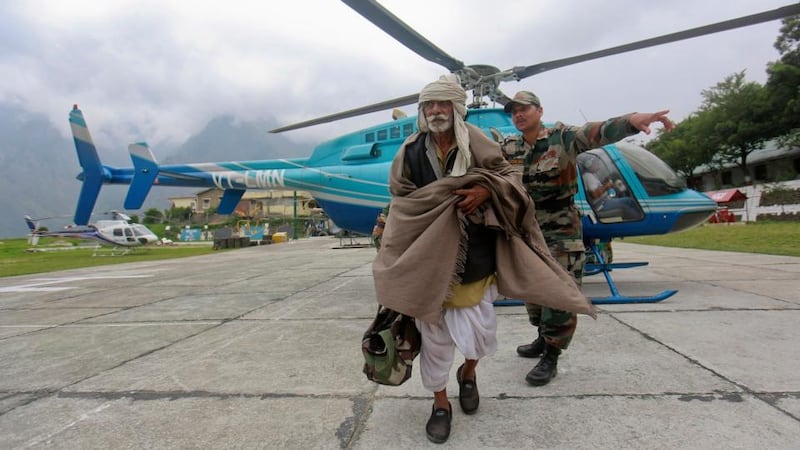Hundreds of people have fled their homes in a north Indian Himalayan town after the ground beneath it began steadily sinking, leading to giant fissures in houses, workplaces, schools, paths and streets, and the collapse of a Hindu temple.
Environmentalists have said indiscriminate and unplanned development over six decades, despite frequent warnings, had led to Joshimath, located at an altitude of 1,874m 500km northeast of New Delhi in Uttarakhand state, subsiding 5cm over the last week, according to satellite imagery recorded by the Indian Space Research Organisation.
More than 100 families from an overall population of about 25,000 have been evacuated to government-run relief camps, after major cracks appeared in some 1,100 of Josimath’s 4,500 residences and various surrounding structures, officials said
Last week, the local municipality began demolishing two hotels that were leaning precariously on each other because of Joshimath’s subsidence. But the authorities cannot contain the continuous flow of water gushing down from the surrounding hillsides, threatening to completely inundate several neighbourhoods.
Russia regains influence in its ‘near abroad’ as West wraps itself in red lines
‘They just want us to work and have babies.’ Exasperation in China as Halloween falls foul of authorities
Tories shout ‘we told you so’ after Rachel Reeves’ tax-and-spend Labour budget
How Trump allies could challenge US presidential election result
“The land has been subsiding in my ward over the past year and its sinking has increased due to the blasting being carried out for varied [road and other] construction activity,” Deepa Devi, a member of Joshimath’s municipal board, told the Hindustan Times.
[ Children of India’s burning coalfields dream of a fire-free futureOpens in new window ]
Other residents told television news channels that the government had ignored obvious warning signs of the looming disaster and “recklessly” kept developing Joshimath’s infrastructure.
In response, a rattled state administration issued a “gag order” last weekend on officials and environmental experts, preventing them from sharing data on Joshimath’s situation on social media. Locals claimed this fiat was increasingly proving “dangerous and counterproductive”.

According to Chandra Bhushan of the International Forum for Environment, Sustainability and Technology in Delhi, the subsidence was predicted, as the town’s gradual sinking had been documented over 50 years by numerous supreme court-appointed committees and federal and state government commissions.
Their findings and conclusions, he said, had warned against the region’s haphazard urbanisation, large-scale hydropower development, arbitrary construction and slicing through hills and decimating forests to build and widen roads. But time and again, Bhushan said, these warnings had been ignored, sealing Joshimath’s fate.
In 1976, an official report warned that Joshimath was sinking and recommended a ban on all heavy construction, as the township was perched precariously on the middle slope of a precipitous hill and built on the debris of a landslide activated by an earthquake more than a century earlier.
[ India legal case concludes after 72 yearsOpens in new window ]
But successive state governments built 39 hydroelectric projects, and 25 more are being constructed, following questionable environmental approval. An additional 180 hydroelectric projects are planned.
Experts said the Tapovan Viushnuhad hydroelectric project, which was scheduled for completion in 2013 but remains under construction, is a major concern. Its tunnel passes under Joshimath’s geologically fragile mountains. These hills have a history of flooding and landslides dating back to 1880, when about 2,100 people died. Some 400 villages have recently been declared unsafe for habitation
Hundreds of hotels, guest houses and unauthorised restaurants have been built in Joshimath over decades to cater to tens of thousands of pilgrims who pass through it each year on the way to a clutch of Hindu temples in nearby Badrinath and the nearby Hemkunt Sahib Sikh shrine.

Many tourists, trekkers and skiers flock to Joshimath during summer, resulting in new roads and tunnels being bored into hillsides to improve connectivity and to increase development. Over-extraction of groundwater and drainage of crucial aquifers have also irreparably ravaged the entire region.
And while Joshimath’s residents face the prospect of homelessness, prime minister Narendra Modi’s BJP-led government is pursuing an all-weather 719km-long road project, connecting the plains to the many Hindu pilgrim spots in the mountains around the beleaguered town. India’s supreme court, in response to a petition in 2021 challenging this project, has set aside environmental concerns over carving highways out of the brittle mountainsides on national security grounds, as some lead to India’s disputed border with China.





